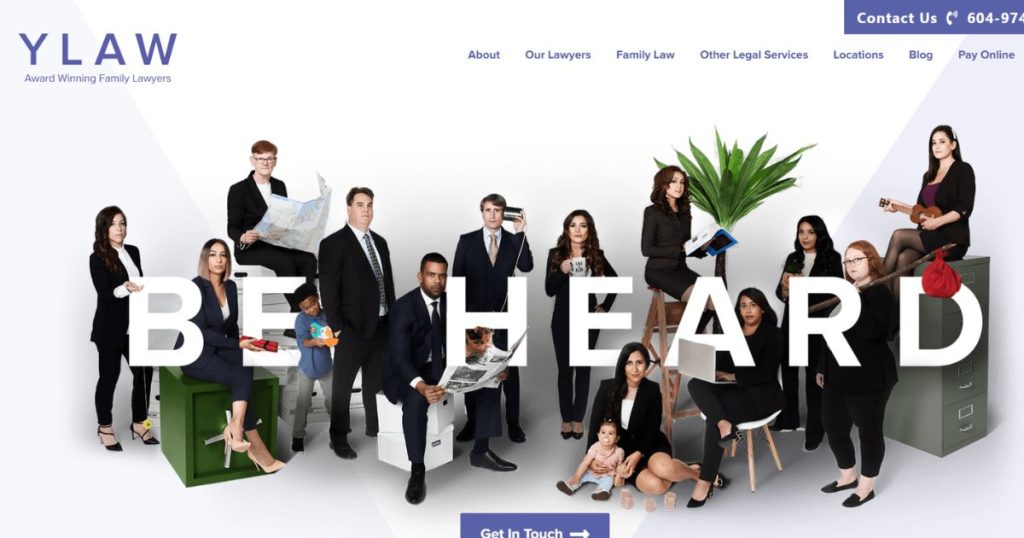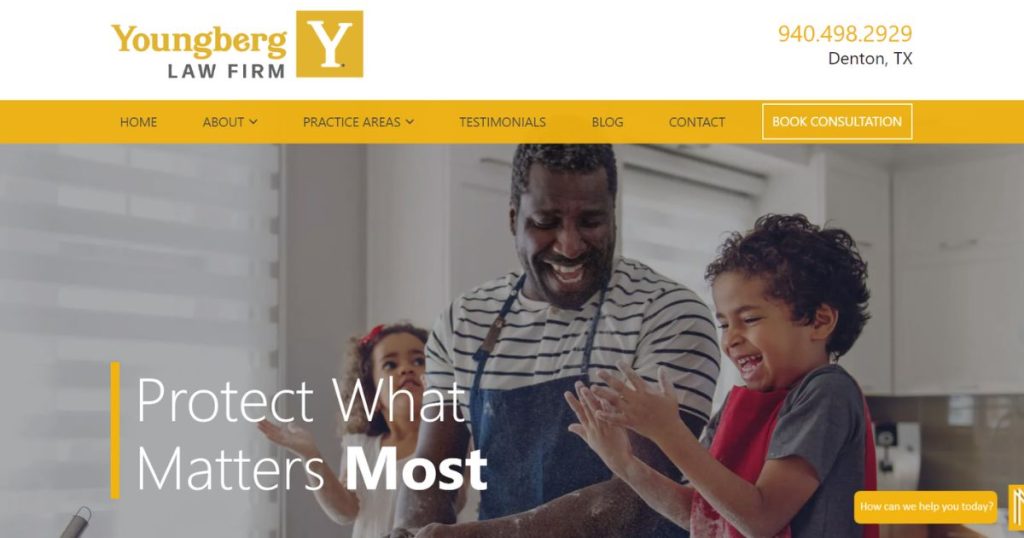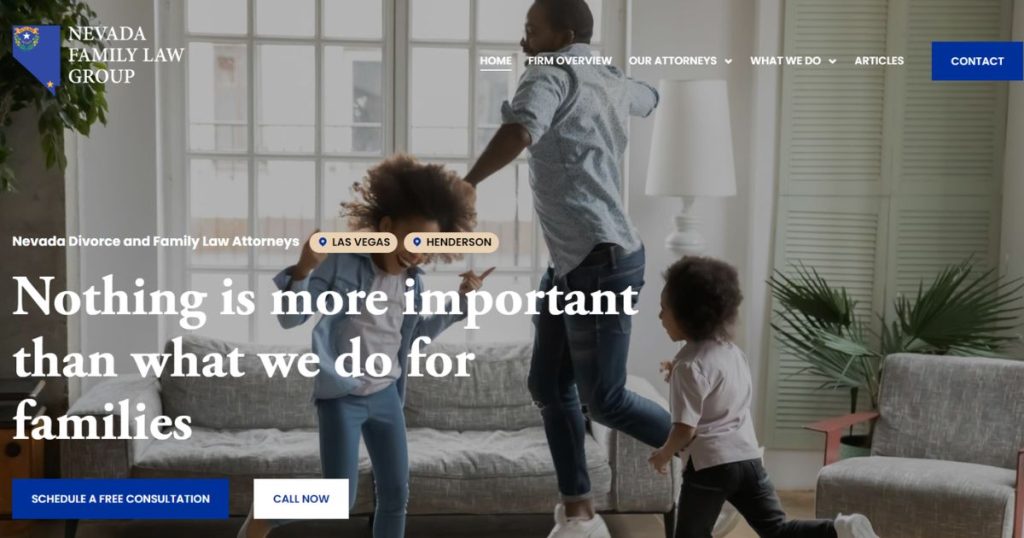Best Guide on Web Design for Family Lawyers
As a family lawyer, you know how important it is to have a well-designed website that showcases your expertise and attracts potential clients. Your website is often the first impression that people have of you and your firm, and it can make or break your online reputation. But how do you create a website that is informative, professional, and easy to navigate?
In this blog post, we will provide a guide to effective web design for family lawyers. We will cover the key elements of a good website design, the content strategy that you should follow, the search engine optimization (SEO) techniques that you should implement, and the call-to-action (CTA) that you should include on your website.
Importance of Web Design for Family Lawyers:
Your website serves as a virtual representation of your law practice. It creates the first impression potential clients have of your services. A poorly designed website may deter clients, while an attractive and user-friendly one can engage them from the start.
Purpose of the Blog Post:
This blog post aims to provide family lawyers with a comprehensive understanding of effective website design principles, emphasizing key elements, content strategy, search engine optimization (SEO), and the importance of compelling calls-to-action (CTAs).
Key Elements of Effective Website Design
A good website design is not only aesthetically pleasing but also functional and user-friendly. Here are some of the key elements that you should consider when designing your website:
- Simple and Clean Layout:
- Ensure a clutter-free design that conveys professionalism.
- Organize information logically and prioritize key content.
- Use appropriate font styles and sizes for readability.
- Clear Navigation:
- Implement intuitive navigation menus for easy website exploration.
- Categorize content under relevant headings and subheadings.
- Include a search function for quick information retrieval.
- Use of Color and Imagery:
- Choose a color scheme that aligns with your brand and evokes the right emotions.
- Utilize high-quality images that resonate with your target audience.
- Balance text and visual elements for an aesthetically pleasing design.
- Consistent Branding:
- Maintain consistent branding throughout your website.
- Use your logo, brand colors, and fonts consistently across pages.
- Ensure your website aligns with your overall brand identity.
- Mobile Responsiveness:
- Optimize your website for mobile devices to accommodate users on smartphones and tablets.
- Ensure responsive design to provide a seamless user experience across different screen sizes.
- Test your website on multiple devices and platforms to guarantee compatibility.
In brief Website Elements for Web Design for Family Lawyers
- Simple and clean layout: Your website should have a simple and clean layout that is easy to scan and understand. Avoid cluttering your website with too many elements, such as text, images, buttons, or links. Use white space to create contrast and hierarchy, and use headings and subheadings to organize your content.
- Clear navigation: Your website should have clear navigation that allows users to find what they are looking for quickly and easily. Use descriptive labels for your menu items, and make sure that they are visible and accessible on every page. Provide a search function and a sitemap for users who want to find specific information on your website.
- Use of color and imagery: Your website should use color and imagery that reflect your brand identity and personality. Choose colors that are appropriate for your niche and target audience, and use them consistently throughout your website. Use high-quality images that are relevant to your content and services, and optimize them for fast loading and SEO.
- Consistent branding: Your website should have consistent branding that conveys your professionalism and credibility. Use a logo that represents your firm, and place it in a prominent position on your website. Use a font that is legible and matches your brand voice, and use the same font size and style across your website. Use a tone of voice that is friendly and authoritative, and communicate your value proposition.
- Mobile responsiveness: Your website should be mobile responsive, meaning that it adapts to different screen sizes and devices. More and more people are using their smartphones and tablets to access the internet, so you need to make sure that your website looks good and works well on mobile devices. Use a responsive design framework or a mobile-friendly theme for your website, and test it on various devices to ensure optimal performance.
Content Strategy
A good website design is not enough if you don’t have good content to back it up. Content is what informs, educates, entertains, and persuades your visitors to take action. Here are some of the types of content that you should include on your website:
- Importance of Content Strategy:
- Engaging and informative content enhances your website’s credibility.
- Establish yourself as an authority by sharing relevant legal insights.
- Address common concerns and provide valuable resources for potential clients.
- Types of Content to Include on Your Website:
- Attorney profiles and practice area descriptions.
- Frequently asked questions (FAQs) addressing common legal inquiries.
- Educational articles, blog posts, and legal guides.
- Testimonials and success stories to build trust.
- Tips for Creating Engaging Content:
- Write in a clear and accessible manner, avoiding excessive legal jargon.
- Use headings, subheadings, and bullet points for easy readability.
- Incorporate multimedia elements, such as videos or infographics, to enhance engagement.
In brief Content Marketing Points for Web Design for Family Lawyers
- Homepage: Your homepage is the most important page on your website, as it is the first page that most visitors will see. Your homepage should provide an overview of who you are, what you do, how you can help, and why you are different from other family lawyers. It should also include a clear CTA that invites visitors to contact you or learn more about your services.
- About page: Your about page is where you can tell your story and showcase your credentials. It should include information about your firm’s history, mission, vision, values, achievements, awards, testimonials, social proof, team members, etc. It should also include a CTA that encourages visitors to get in touch with you or book a consultation.
- Services page: Your services page is where you can explain what kind of services you offer as a family lawyer, such as divorce, child custody, alimony, adoption, etc. It should include information about the benefits of hiring you as their lawyer, the process of working with you, the fees involved, the expected outcomes, etc. It should also include a CTA that prompts visitors to request a quote or schedule an appointment.
- Blog page: Your blog page is where you can share your expertise and insights on various topics related to family law. It should include articles that are informative, engaging, and relevant to your target audience. You can use your blog to educate your readers about the legal issues that they may face, provide tips and advice on how to handle them, answer frequently asked questions, share case studies, and success stories, etc. Your blog should also include a CTA that invites readers to comment, share, subscribe, or contact you for more information.
Search Engine Optimization (SEO)
Search engine optimization (SEO) is the process of improving your website’s visibility and ranking on search engines like Google. SEO is important for family lawyers because it helps you reach more potential clients who are searching for your services online. Here are some of the key elements of SEO that you should implement on your website:
- Importance of SEO for Family Lawyers:
- SEO improves your website’s visibility in search engine results.
- Higher rankings increase organic traffic and potential client conversions.
- Keyword optimization ensures your website appears in relevant search queries.
- Key Elements of SEO:
- Conduct keyword research to identify relevant terms and phrases.
- Optimize on-page elements such as title tags, meta descriptions, and headings.
- Build high-quality backlinks from reputable legal directories and relevant websites.
- Tips for Optimizing Your Website for Search Engines:
- Create unique, informative, and keyword-rich page titles and meta descriptions.
- Optimize your website’s loading speed for better user experience.
- Develop a solid internal linking structure to enhance website navigation.
In brief SEO Points for Web Design for Family Lawyers
- Keywords: Keywords are the words and phrases that users type into search engines to find what they are looking for. You should conduct keyword research to identify the most relevant and popular keywords for your niche and target audience and use them strategically throughout your website content, titles, headings, meta tags, URLs, etc. You should also use long-tail keywords, which are more specific and less competitive than short-tail keywords.
- Content: Content is the king of SEO, as it is what provides value and information to your visitors and search engines. You should create high-quality content that is original, useful, accurate, and up-to-date. You should also update your content regularly to keep it fresh and relevant. You should avoid duplicate content, which is content that appears on more than one page or website, as it can harm your SEO ranking.
- Links: Links are the connections between your website and other websites. There are two types of links: internal links and external links. Internal links are links that point to other pages on your website, and they help users navigate your website and search engines crawl your website. External links are links that point to other websites, and they help you establish authority and credibility in your field. You should use both types of links on your website, but make sure that they are relevant and trustworthy. You should avoid broken links, which are links that lead to non-existent or error pages, as they can damage your SEO ranking.
Call-to-Action (CTA)
A call-to-action (CTA) is a statement or a button that urges your visitors to take a specific action on your website. A CTA is important for family lawyers because it helps you convert your visitors into leads or clients. Here are some examples of effective CTAs for family lawyers:
- Importance of CTAs:
- CTAs prompt potential clients to take action, such as contacting your law firm or scheduling a consultation.
- Well-designed CTAs guide visitors towards the next step in the client acquisition process.
- They encourage engagement, lead generation, and conversions.
- Examples of Effective CTAs for Family Lawyers:
- “Schedule a Consultation Now” – Encourage potential clients to book an appointment directly from your website.
- “Contact Us for Expert Legal Advice” – Provide a clear and direct way for visitors to reach out to your firm.
- “Subscribe to Our Newsletter for the Latest Legal Insights” – Build an email subscriber list for ongoing communication.
In brief CTA Points for Web Design for Family Lawyers
- Contact us: This CTA invites visitors to contact you via phone, email, or a contact form. You should place this CTA on every page of your website, especially on your homepage, about page, and services page. You should also make sure that your contact information is clear and visible on your website.
- Book a consultation: This CTA invites visitors to book a free or paid consultation with you or one of your team members. You should place this CTA on your services page and blog page, where visitors may have questions or concerns about their legal issues. You should also provide a calendar or a booking system that allows visitors to choose a convenient time slot for their consultation.
- Download a guide: This CTA invites visitors to download a free guide or ebook that provides valuable information or tips on a specific topic related to family law. You should place this CTA on your blog page or landing page, where visitors may be interested in learning more about a certain subject. You should also ask visitors to provide their names and email address in exchange for the guide or ebook so that you can build your email list and follow up with them later.
Design Inspiration on Web Design for Family Lawyers
Family & Divorce Lawyers in Vancouver

YLaw is a trusted Canadian law firm specializing in family law, with a team of experienced lawyers committed to providing personalized legal solutions and support to their clients in Vancouver and the surrounding areas.
Grand Rapids Family Lawyer

Kraayeveld Law Offices offers comprehensive legal services in family law, divorce, child custody, and more. Based in the Netherlands, their skilled attorneys are dedicated to guiding clients through challenging legal matters with compassion and expertise.
Modern Family Law

Modern Family Law is a premier law firm based in the United States, focusing exclusively on family law cases. Their website provides valuable resources, legal insights, and access to a dedicated team of professionals committed to protecting the rights and interests of their clients.
Youngberg Law Firm

Youngberg Family Law is a trusted family law firm serving clients in Minnesota. With their compassionate approach and extensive experience, they provide effective legal representation for divorce, child custody, adoption, and other family-related matters.
Nevada Family Law: Best Web Design for Family Lawyers

Nevada Family Law is a reputable law firm located in Nevada, specializing in family law and divorce cases. Their website offers useful information, guidance, and access to skilled attorneys who are dedicated to helping clients navigate the complexities of family law matters in the state of Nevada.
Conclusion on Web Design for Family Lawyers
Well folks, we’ve come to the end of our journey through website design for family lawyers. And let me tell you, it’s been a wild ride. We’ve seen some truly stunning websites, and some that made us want to gouge our eyes out with a spoon. But through it all, we’ve learned some valuable lessons.
First and foremost, if you’re a family lawyer and your website looks like it was designed in 1995, it’s time for an upgrade. We’re not saying you need to have the flashiest, most cutting-edge website out there, but at the very least, make sure it’s easy to navigate and doesn’t give us a headache.
Secondly, don’t be afraid to show a little personality. Family law can be a serious business, but that doesn’t mean your website has to be a snooze-fest. Throw in a joke or two, or maybe a cute picture of a puppy (because who doesn’t love puppies?).
And finally, remember that your website is a reflection of you and your practice. So if you want potential clients to take you seriously, make sure your website looks professional and polished.
So there you have it, folks. Our conclusion on web design for family lawyers. Now go forth and create some killer websites! And if you need any help, you know who to call (hint: it’s not Ghostbusters).
FAQ on Web Design for Family Lawyer
How long does it take to design and develop a website for a family lawyer?
The timeline for website design and development can vary depending on several factors, such as the complexity of the project, the availability of content and resources, and the responsiveness of the client. On average, it can take anywhere from a few weeks to a couple of months to design and launch a professional website for a family lawyer.
Can I update and manage my website content on my own?
Yes, absolutely! A well-designed website for a family lawyer should include a user-friendly content management system (CMS) that allows you to easily update and manage your website content without requiring technical expertise. With a CMS, you can add new pages, modify existing content, publish blog posts, and make other changes to your website conveniently.
How can I ensure my website is search engine friendly?
To make your website search engine friendly, you should focus on implementing search engine optimization (SEO) best practices. This includes conducting keyword research and incorporating relevant keywords into your content, optimizing meta tags and headers, creating descriptive URLs, improving website speed and performance, and ensuring your site is mobile-friendly and responsive.
Should I include a contact form on my website?
Yes, including a contact form on your website is highly recommended. A contact form provides a convenient way for potential clients to reach out to you without having to compose an email or make a phone call. Make sure your contact form is prominently placed on your website and includes fields for name, email address, phone number, and a message box for inquiries or comments.
Can I integrate social media into my website?
Absolutely! Integrating social media into your website can help you expand your online presence and engage with your audience on various platforms. You can include social media buttons or widgets that link to your social media profiles, allowing visitors to follow and share your content.








